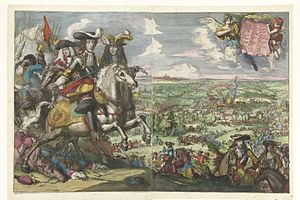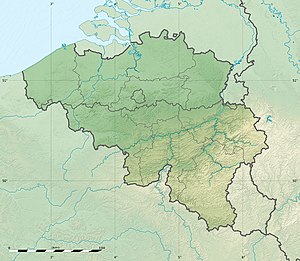Battle of Saint-Denis (1678)
| Battle of Saint-Denis | |||||||
|---|---|---|---|---|---|---|---|
| Part of the Franco-Dutch War | |||||||
 Battle of Saint-Denis by Romeyn de Hooghe | |||||||
| |||||||
| Belligerents | |||||||
|
|
| ||||||
| Commanders and leaders | |||||||
|
|
| ||||||
| Strength | |||||||
| 40,000 | 45,000 | ||||||
| Casualties and losses | |||||||
| 4,000 | 4,500–5,000 | ||||||
The Battle of Saint-Denis was the last major action of the Franco-Dutch War, which took place on 14 August 1678, four days after France and the Dutch Republic signed the Treaty of Nijmegen. The battle was fought to prevent the French capturing the town of Mons, then on the border between France and the Spanish Netherlands, now modern Belgium. Its result is disputed.
Fighting was concentrated around the nearby villages of Saint-Denis and Casteau. A French army of 40,000 under Marshal Luxembourg was attacked by an Allied Dutch-Spanish army of 45,000 led by William of Orange. A series of Allied assaults were successfully repulsed by the French and William ordered a retreat after six hours of fighting. However, Luxembourg abandoned the siege the next day and Spain retained Mons in the treaty agreed with France on 17 September.
Background[]

France viewed possession of the Spanish Netherlands as essential for its security and trade and occupied much of it in the 1667 to 1668 War of Devolution. Having won their independence in 1648, the Dutch Republic preferred a weakened Spain as a neighbour, rather than an aggressive and expansionist France. As a result, the Dutch-led Triple Alliance forced Louis XIV of France to return most of his gains in the 1668 Treaty of Aix-la-Chapelle.[1] Thereafter, Louis decided the best way to force concessions from the Dutch was by first defeating them.[2]
Initially supported by England, the Franco-Dutch War began in May 1672; French troops quickly overran much of the Netherlands, but by July the Dutch position had stabilised. Success encouraged Louis to make excessive demands, while concern at French advances brought the Dutch support from Brandenburg-Prussia, Emperor Leopold, and Charles II of Spain. In August 1673, an Imperial army entered the Rhineland; facing war on multiple fronts, the French abandoned most of their Dutch gains to focus elsewhere, retaining only Grave and Maastricht.[3] In January 1674, Denmark joined the anti-French coalition, while in February England left the war via the Treaty of Westminster.[4]
In the first part of 1674, Louis focused on recapturing Franche-Comté, which was completed by the end of June and French troops transferred to Condé's army in the Spanish Netherlands. Both sides suffered heavy losses in the Battle of Seneffe on 11 August, which confirmed Louis' preference for positional warfare, with siege and manoeuvre dominating in this theatre thereafter.[5] The peace talks that began at Nijmegen in 1676 were given a greater sense of urgency in November 1677 when William of Orange married his cousin Mary, Charles II of England's niece. An Anglo-Dutch defensive alliance followed in March 1678, although English troops did not arrive in significant numbers until late May. This allowed Louis to improve his negotiating position by capturing Ypres and Ghent in early March, before signing a peace treaty with the Dutch on 10 August.[6]
Battle[]

French strategy was driven by Vauban's pré carré plan, a double-line of fortresses to protect their northern borders (See Map). Mons was the most significant position still held by the Spanish; although the Dutch had agreed terms with France, Spain had not yet done so, and the delay provided an opportunity to capture it.[6]
During the March offensive that secured Ypres and Ghent, a French force under the Comte de Montal was based at Saint-Ghislain and Marville to blockade Mons. After England's entry into the war, Marshal Luxembourg was ordered to stay on the defensive but prevent any attempt to relieve it. On 12 August, his army of 40,000 was camped in the nearby villages of Saint-Denis and Casteau, with a Dutch and Spanish force of 45,000 based at Soignies, about three hours march away.[7]
William and Villahermosa were aware the Dutch were close to agreeing terms with France, but decided to attack anyway. The war with Spain continued regardless, and preventing the loss of Mons benefitted both the Spanish and Dutch.[8] Luxembourg, who was based in the Abbey de St Denis, an exposed position in front of the French right wing, reportedly learned of the Treaty on the morning of 14 August.[9]
Early in the afternoon, Villeroy reported the Allies were advancing on the abbey; assuming this to be a feint, Luxembourg ordered his artillery and baggage train to withdraw towards de Montal's positions at Saint-Ghislain. About 15:00, German mercenaries under Count Waldeck captured the Abbey, while Spanish and Dutch infantry, including the Anglo-Scots Brigade, attacked Villeroy's troops around Casteau. Concentrating on a narrow front allowed the Allies to take most of the village, but they failed to break Villeroy's front line.[10]

Once Luxembourg realised this was not a feint, he brought up his reserves; the battle for Casteau lasted over five hours, with church, mill and chateau changing hands several times. Both sides suffered heavy casualties in fierce hand-to-hand fighting; Luxembourg suffered minor wounds, while William was reportedly saved by future Marshal Hendrik Overkirk, who killed a French dragoon with his pistol against the Prince's chest.[11]
The Allies began to withdraw around 19:00, leaving troops in Casteau to cover their retreat, which then pulled back, with the exception of a regiment of French Huguenots exiles holding the chateau. Commanded by a former French regular officer, M de La Roque-Servière, they continued fighting until over-run just after 21:00, when the battle ended.[12]
French casualties were around 4,000 killed or wounded, including 689 in the elite Gardes Francaises, those of the Allies between 4,500 and 5,000.[13] The only British troops involved were the six regiments of the Anglo-Scots Brigade in Dutch service, commanded by the Earl of Ossory; while Monmouth was present and reportedly took part in a number of cavalry charges, the English Brigade which he commanded had not yet joined the main army.[14]
Aftermath[]
The French incurred fewer casualties and remained in possession of the battlefield, allowing them to claim victory under the usage of the period, but the Allies achieved their strategic objective of ensuring Mons remained in Spanish hands. As a consequence, the result is disputed; it has been described as a French victory,[15][16] a narrow Dutch defeat,[17] or Dutch victory.[18]
Spain and France agreed an armistice on 19 August, with a formal peace treaty signed on 17 September. France returned Charleroi, Ghent and other towns in the Spanish Netherlands, but Spain ceded Ypres, Maubeuge, Câteau-Cambrésis, Valenciennes, Saint-Omer and Cassel; with the exception of Ypres, all of these remain part of modern France.[19]
References[]
- ^ Macintosh 1973, p. 165.
- ^ Lynn 1996, pp. 109–110.
- ^ Lynn 1996, pp. 123���124.
- ^ Hutton 1989, p. 317.
- ^ Lynn 1996, p. 125.
- ^ Jump up to: a b Lesaffer.
- ^ De Périni 1896, pp. 224–225.
- ^ Lynn 1996, p. 152.
- ^ De Périni 1896, p. 227.
- ^ De Périni 1896, pp. 228–229.
- ^ Frey & Frey 1995, p. 306.
- ^ De Périni 1896, pp. 230–232.
- ^ De Périni 1896, pp. 234–235.
- ^ Ede-Borrett 2003, pp. 278–281.
- ^ Sandler 2002, p. 514.
- ^ Dupuy & Dupuy 1993, p. 566.
- ^ Kossmann 1975, p. 296.
- ^ Nimwegen 2010, p. 510.
- ^ Nolan 2008, p. 128.
Sources[]
- Davenport, Frances (1917). European Treaties bearing on the History of the United States and its Dependencies. Washington, D.C. Carnegie Institution of Washington.
- De Périni, Hardÿ (1896). Batailles françaises, Volume V (in French). Ernest Flammarion, Paris.
- Dupuy, Richard Ernest; Dupuy, Trevor (1993). The Harper's Encyclopedia of Military History from 3500 B.C. to the Present. HarperCollins Publishers.
- Ede-Borrett, Stephen (2003). "Casualties in the Anglo-Dutch Brigade at the battle of St Denis August 1678". Journal of the Society for Army Historical Research. 81 (327). JSTOR 44230964.
- Frey, Linda; Frey, Marsha (1995). The Treaties of the War of the Spanish Succession: An Historical and Critical Dictionary. Greenwood. ISBN 978-0313278846.
- Kossmann, E.H. (1975). "The Dutch Republic". In Carsten, F.L. (ed.). The New Cambridge Modern History. V: The Ascendancy of France: 1648-88. Cambridge University Press.
- Lesaffer, Randall. "The Wars of Louis XIV in Treaties (Part V): The Peace of Nijmegen (1678–1679)". Oxford Public International Law. Retrieved 30 December 2018.
- Lynn, John (1996). The Wars of Louis XIV, 1667-1714 (Modern Wars In Perspective). Longman. ISBN 978-0582056299.
- Macintosh, Claude Truman (1973). French Diplomacy during the War of Devolution, the Triple Alliance and the Treaty of Aix-la-Chapelle (PhD). Ohio State University.
- Nimwegen, Olaf van (2010). The Dutch Army and the Military Revolutions, 1588-1688. Boydell & Brewer. ISBN 978-1843835752.
- Nolan, Cathal J (2008). Wars of the age of Louis XIV, 1650–1715. ABC-CLIO. ISBN 978-0-313-33046-9.
- Sandler, Stanley (2002). Ground Warfare: An International Encyclopedia. 1. ABC-CLIO. ISBN 978-1-57607-344-5.
- Conflicts in 1678
- Battles involving the Dutch Republic
- Battles involving France
- Battles involving Spain
- 1678 in France
- History of Mons
- History of Wallonia
